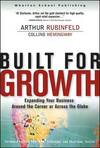 Like McDonald’s, Starbucks is a concept driven as much by real estate as it is by coffee and the coffee experience. These days Starbucks opens at least three new locations a day somewhere in the world. It has taken a lot of real estate to open up 9,000+ Starbucks locations and it will take even more real estate to reach their stated goal of 30,000 global locations.
Like McDonald’s, Starbucks is a concept driven as much by real estate as it is by coffee and the coffee experience. These days Starbucks opens at least three new locations a day somewhere in the world. It has taken a lot of real estate to open up 9,000+ Starbucks locations and it will take even more real estate to reach their stated goal of 30,000 global locations.
There is much to learn about Starbucks expertise in the real estate game and Arthur Rubinfeld, former EVP of Real Estate with Starbucks, shares many of these learnings in BUILT FOR GROWTH (Wharton Publishing, 2005).
[Heads Up | Arthur covers a lot of territory in this book including branding, business model infrastructure, retail site selection, innovation, and delivering customer experiences. BUILT FOR GROWTH is at its best sharing real estate advice more so than anything else.]
Beginning with Ch. 12, Arthur shares actionable insights into how Starbucks gained market dominance through finding the best real estate locations.
For example, have you ever wondered why so many Starbucks stores are located near dry cleaners and video stores? That’s so Starbucks can take advantage of the ‘going-to-work’ traffic generated from people dropping off clothes at the dry cleaners on their way to work. And, Starbucks takes advantage of people picking up movies from Blockbuster on their way home from work.
Arthur mentions his secret for locating heavily trafficked parking lots – oil stains. Yep, if a parking lot has lots of oil stains, it means lots of cars come and go.
“In retailing,” Arthur says, “you are judged by the company you keep.” That’s why he advocates always locating your store near other tenants who attract a more affluent customer base than does your store. Starbucks avoids locating stores in close proximity to fast food chains because these restaurants generally draw a less affluent customer.
Small business owners looking to become big business owners should pay close attention to the site selection process Arthur shares in Chapter 14. It’s straight from the Starbucks playbook. In fact, you can download a Real Estate Decision Logic Template and a Site Evaluation Form from the book’s website. These templates look very similar to ones Starbucks used in the mid-to-late 90s. (To access these templates as well as other tools, you will need to ‘register’ with the site.)